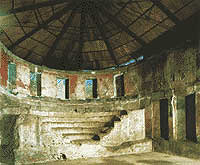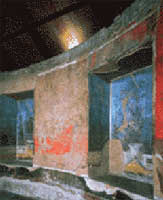

Mecenate's Auditorium


|
During the opening of the via Merulana in 1874, a large complex of ancient buildings was discovered, although the auditorium was the only structure conserved. The auditorium was a large, apsidal room about 24m long, which was divided into four parts: a vestibule on the southeast end, the main hall (11m wide and 13m long), an exedra with steps, and a double access ramp on the southeast end. The auditorium, built of travertine, or volcanic rock, was probably once protected with a vaulted covering and decorated with statues, as indicated by the six niches found in the walls. The frescoes which once embellished the hall are now lost. The caristio marble, which was essentially used in the niches and for the steps of the exedra, is commonly called "cipollino," or little onion, because of its coloring and unusual patterns. Except for this hall, the entire complex, identified as the Villa of Mecenate, was demolished. During the opening of the via Merulana in 1874, a large complex of ancient buildings was discovered, although the auditorium was the only structure conserved. The auditorium was a large, apsidal room about 24m long, which was divided into four parts: a vestibule on the southeast end, the main hall (11m wide and 13m long), an exedra with steps, and a double access ramp on the southeast end. The auditorium, built of travertine, or volcanic rock, was probably once protected with a vaulted covering and decorated with statues, as indicated by the six niches found in the walls. The frescoes which once embellished the hall are now lost. The caristio marble, which was essentially used in the niches and for the steps of the exedra, is commonly called "cipollino," or little onion, because of its coloring and unusual patterns. Except for this hall, the entire complex, identified as the Villa of Mecenate, was demolished.
|